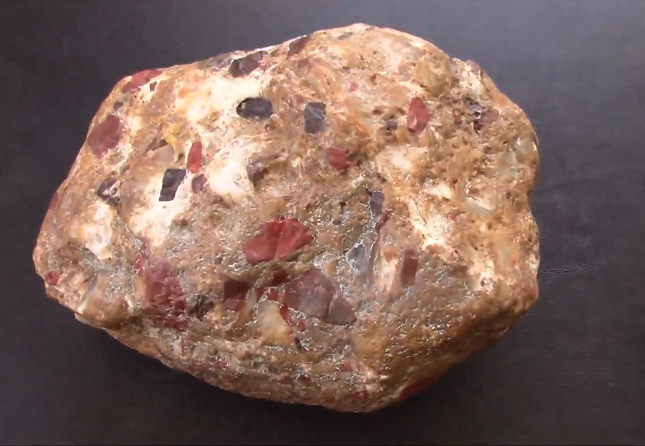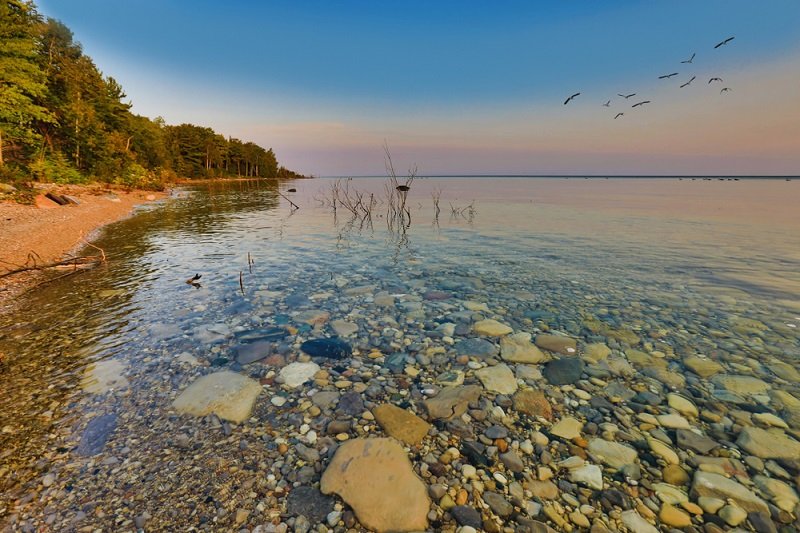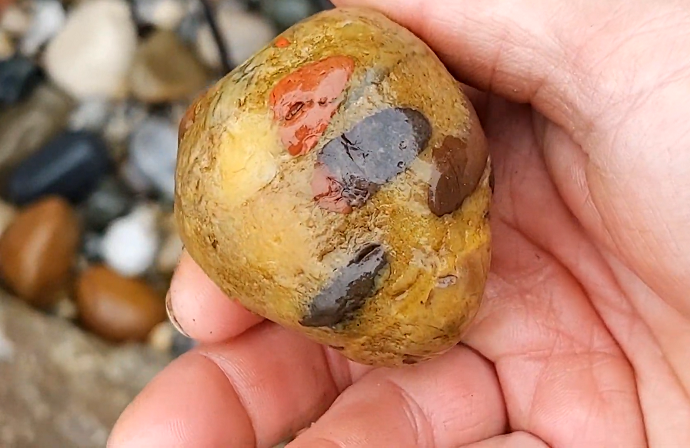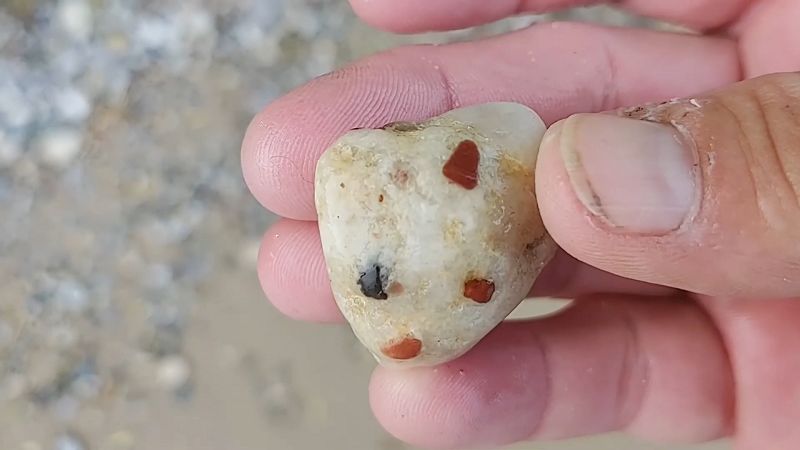Puddingstone is the unofficial name given to quartz conglomerate. This stone ranges from small pebbles to huge boulders and has been found throughout the world. You may never have heard the name puddingstone, but it is very likely you have seen at least one. This is especially true if you spend much time near flowing streams, especially in lower Canada and the upper Michigan areas. The Great Lakes region is very popular for hunting this unusual stone.
What Is a Puddingstone?
Walking along, you come across a stone that appears to be several round pebbles embedded in a lighter stone. This is what has long been referred to as a puddingstone. The pebbles that are embedded are often rounded but they can be of various shapes. There are also a variety of sizes and colors. This is because these pebbles were once single stones lying in stream beds. The lighter material that has become a home for these pebbles is most often white quartz sand. While other sandy materials have been found throughout the world, white quartz is the most popular.
Different Types of Puddingstone
There are many types of puddingstone. The most popular is Michigan Puddingstone, which has been part of the traditions in the Michigan area for generations. This stone is believed to have come into the area way back in the time of the Ice Age. It is also where most of the really large stones have been found. Some of the more popular types of puddingstone are:
Hertfordshire Puddingstone: These are mainly located in Hertfordshire, England.
Bearfort Mountain Puddingstone: Found in northern New Jersey and boasts bright purple stones.
Roxbury Puddingstone: Found in and around Boston, Massachusetts, and is one of the reasons this stone is the official state stone.
Plumstead Commons Puddingstone: From London, England, these have been around since the Ice Age and are the source of many local legends.
St. Joseph Island Puddingstone: Can be found in the Ontario, Canada area. These stones contain pieces of brown and red jasper, which is a type of quartz.
These are only a sampling of the many different types of puddingstones you can find.
What Is Inside Puddingstones?

One of the best things about pudding stones is that every location offers a different conglomerate of materials making up the stones.
In most cases, you can find red jasper, black chert, white quartzite, hematite, and semi-transparent quartz. While other places offer shale, slate, and other stones that have found their way to running water.
In very rare instances, people have found pieces of diamond, gold, and other precious stones, but these are few and far between.
The material binding all of these stones together also varies. The main thing that is needed is that it starts out as a sandy-type material. Stones have been found with white, brown, black, and red binding material. Some of the most interesting things that have been found in a puddingstone are fossils from small plants and sea life that got trapped in the silt before it hardened.
Why Is It Called Puddingstone?
Puddingstone got its name centuries ago from the English. The English love puddings and they are known for putting all sorts of nuts and fruits in them. Someone thought the originally found stones looked like a glob of pudding that had been stuffed with nuts, raisins, and bits of cranberries. The name seemed to find favor and has stuck. It seems fitting that such an unusual stone should sport an unusual name.
Where To Find Puddingstones

Besides Michigan and England, you can find puddingstones all over the world. Each location has stones that are made up of a different composite of both pebbles and binding material.
The best place to look for these unique rocks is along the upper Great Lakes region of the United States and in lower Canada. The stones, however, have been found in Australia, India, and France.
The most unique location has been a puddingstone photographed by NASA’s Curiosity. It was filmed on Mars. This helps us understand many things about the climate of both our planet and now Mars.
Puddingstones are most commonly found on the shores of running water, but some have been uncovered by farmers as they plowed their fields and now the one that has been found on Mars, which doesn’t currently show running water. This tells us that the landscape of many places that are now drier were once near water.
How Are Puddingstones Formed?

Things started near a network of rapidly-flowing streams where pebbles of many types were found being tossed about in the current. These pebbles included such stones as red and brown jasper, hematite, chert, and quartz, along with other stones in the area. This is believed to have begun in Canada.
As the weather changed, some of these pebbles, now all mixed together, were deposited in troughs along the river beds. The current had slowed, so the heavier stones fell into the sandy sediment. Many of these streams and rivers dried up, leaving the rocks behind. As time passed, the changes in cold and heat eventually caused the sandy sediment to harden. As it did so, the pebbles became trapped and eventually glued together by the now solid sand. Pressure and heat occurred around this time. This caused the material to become quartzite, a very strong material.
Along came the Ice Age. The quartzite formations became frozen in glaciers. As time passed and the Earth begin to warm, those glaciers broke free and started traveling with the rivers that were flowing once again. The puddingstones that were trapped in the glaciers traveled until the ice melted enough for them to fall to the ground, once again free. By then, many had traveled to the United States.
It is believed that this event has happened all over the world and that each place where puddingstones have been found is a product of this river tumbling, heat, freezing, and melting cycle.
Fun Historical Facts About Puddingstone

Puddingstones can be found in some of the most unexpected places, besides the one on Mars. England, in fact, has a long history with these stones. Stonehenge sports some of them in its design. Many of the royal castles throughout the English countryside have puddingstones built into them. The stones were thought to be special and offered protection back in the time when these castles were built.
This belief is why, even today, you can find many walkways constructed of puddingstone. They have also been used extensively in walls that surround properties. Today, they have left behind their revered state but are still admired for their unique beauty.
In other areas where this stone is prolific, especially Michigan, generations have built the stones into their traditions. Some families pass down a particularly beautiful stone from parent to child. Others plan day excursions with the family to search for the stones. They pack a lunch and spend the day wandering beaches and along creek beds searching for the most interesting stones. Some people have built up remarkable collections of stones, each one unique.
What To Do With Puddingstone
Besides collecting and displaying puddingstones, there are a few things you can do to display your finds. Many people will use a rock tumbler to polish their stones. You can create a simple display, turn the stones into unique sculptures, or design unique jewelry and house decorations, such as lamp bases with them. Some people have used stones to create garden walkways and fountains. The possibilities are only limited by one’s imagination,
- Online rock and mineral club for collectors of all levels!
- Find community with like-minded rock and mineral enthusiasts.
- Monthly Giveaways!
- Free Access to Entire Digital Library of Products (current and future products)*


